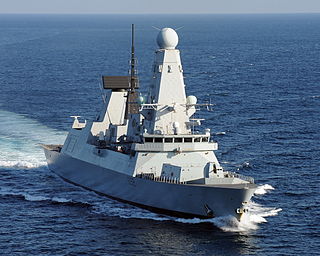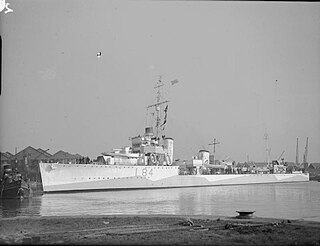This page is based on this
Wikipedia article Text is available under the
CC BY-SA 4.0 license; additional terms may apply.
Images, videos and audio are available under their respective licenses.

In naval terminology, a destroyer is a fast, maneuverable long-endurance warship intended to escort larger vessels in a fleet, convoy or battle group and defend them against smaller powerful short-range attackers. They were originally developed in the late 19th century by Fernando Villaamil for the Spanish Navy as a defense against torpedo boats, and by the time of the Russo-Japanese War in 1904, these "torpedo boat destroyers" (TBDs) were "large, swift, and powerfully armed torpedo boats designed to destroy other torpedo boats". Although the term "destroyer" had been used interchangeably with "TBD" and "torpedo boat destroyer" by navies since 1892, the term "torpedo boat destroyer" had been generally shortened to simply "destroyer" by nearly all navies by the First World War.

HMAS Duchess was a Daring-class destroyer that served in the Royal Navy as HMS Duchess from 1952 to 1964, and in the Royal Australian Navy (RAN) from 1964 to 1980. She was laid down by John I. Thornycroft and Company, and commissioned into the Royal Navy in 1952.
Two ships of the Royal Australian Navy (RAN) have been named HMAS Vampire.
Seven vessels of the British Royal Navy have been named HMS Daring.

The Havock class was a class of torpedo boat destroyer (TBD) of the British Royal Navy. The two ships, Havock and Hornet, built in London in 1893 by Yarrow & Company, were the first TBDs to be completed for the Royal Navy, although the equivalent pair from J.I. Thornycroft, Daring and Decoy, were ordered five days earlier.

HMS Daring is the lead ship of the Type 45 or Daring-class air-defence destroyers built for the Royal Navy, and the seventh ship to hold that name. She was launched in 2006 on the Clyde and conducted contractor's sea trials during 2007 and 2008. She was handed over to the Royal Navy in December 2008, entered her base port of Portsmouth for the first time in January 2009 and was formally commissioned on 23 July 2009. As the lead ship of the first destroyer class built for the Royal Navy since the Type 42 in the 1970s, she has attracted significant media and public attention. Her name, crest and motto are a reference to the Roman youth Gaius Mucius Scaevola, famed for his bravery.
Nine ships of the Royal Navy have borne the name HMS Diana after the figure from Roman mythology, whilst another was planned but later cancelled:

The Thornycroft type leader or Shakespeare class were a class of five destroyer leaders designed by John I. Thornycroft & Company and built by them at Woolston, Southampton for the Royal Navy towards the end of World War I. They were named after historical naval leaders. Only Shakespeare and Spenser were completed in time for wartime service. The other three were completed after the war, Broke and Keppel after being towed to Royal dockyards for completion, and two further ships - Saunders and Spragge - were cancelled. The function of a leader was to carry the flag staff of a destroyer flotilla, therefore they were enlarged to carry additional crew, offices and signalling equipment, allowing a fifth gun to be carried. These ships were very similar to the Admiralty type leader, but had broad, slab-sided funnels characteristic of Thornycroft designs.
The Hawthorn M were a class of two destroyers built for the Royal Navy under the pre-war 1913-14 Programme for World War I service.

The Thornycroft M or Mastiff class were a class of six British destroyers completed for the Royal Navy during 1914-16 for World War I service. They were quite different from the Admiralty-designed ships of the Admiralty M class, although based on a basic sketch layout provided by the Admiralty from which J I Thornycroft developed their own design. Like the 'standard' Admiralty M class they had 3 funnels, but the centre funnel was thicker in the Thornycroft ships. The midships 4 in gun was shipped between the 2nd and 3rd funnels. Patriot was fitted to carry a kite balloon.
In the Royal Navy there have been a variety of naming conventions for destroyers.

The A class as designated in 1913 was a heterogeneous group of torpedo boat destroyers (TBDs) built for the Royal Navy in the mid-1890s. Some 42 vessels were constructed to the individual designs of their builders to meet Admiralty specifications, the only uniting feature being a specified top speed of 27 knots (50 km/h). In fact the initial six vessels were generally differentiated by a slightly lower speed and were often referred to as "26-knotters" to distinguish them from the following batch of thirty-six vessels; all fifteen surviving "27-knotter" vessels were classified by the Admiralty as the A class in 1913 to provide some system to the naming of HM destroyers. All of the "26-knotters" and most of the "27-knotters" had been lost or scrapped before the 1913 classification, but for convenience all 42 ships are listed below. The number of funnels varied from one to four. All vessels had a distinctive "turtleback" forecastle that was intended to clear water from the bow, but actually tended to dig the bow in to anything of a sea, resulting in a very wet conning position.
HMS Verulam was an Admiralty V-class destroyer of the Royal Navy. She was built by Hawthorn Leslie and was launched on 3 October 1917. She struck a mine off the island of Seiskari in the Gulf of Finland on the night between 3–4 September 1919, and sank.

HMS Duncan is the sixth and last of the Type 45 or Daring-class air-defence destroyers built for the Royal Navy. Duncan is named after Adam Duncan, 1st Viscount Duncan, who defeated the Dutch fleet at the Battle of Camperdown on 11 October 1797.

HMS Delight was a Daring-class destroyer of the British Royal Navy, launched in 1950 as the Royal Navy's first all-welded warship, and broken up at Inverkeithing in 1971.

HMS Diamond was a Daring-class destroyer of the British Royal Navy. She was built by John Brown & Company in Clydebank, Scotland, and launched on 14 June 1950. This ship was John Brown & Company's first all-welded ship.












